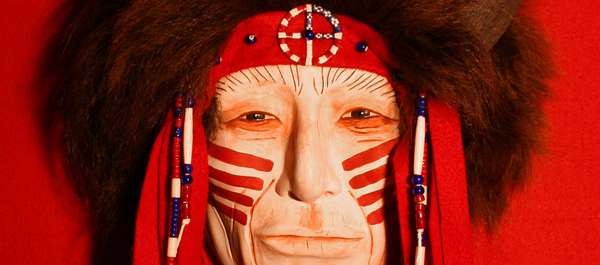
‘I like to just refer to myself as an indigenous artist—as in, indigenous to the Americas’
Its face painted, crowned with a buffalo headdress, Keeper of the Peace is more than just a mask. “Not a mask in the usual sense,” artist Becky Olvera Schultz says, “but a lifelike facial portrait.” This mixed-media wall hanging is a powerful symbol of strength and dignity.
Using her knowledge of tribal imagery and history (“but with my own personal inspiration and style,” says Schultz, “which just comes from within me”), the artist created the 27-by-14-inch clay mask as a blend of contemporary and historic artwork, incorporating paint, beads, horsehair and porcupine quills.
“With Keeper of the Peace, I am also incorporating what was the lifeblood of the Plains tribes—the bison,” Schultz says from her Native Expressions studio in Santa Cruz County, Calif. “This piece has real bison fur and bison horn, which was worn quite often as part of warring, hunting and ceremonial regalia. The medicine wheel on the forehead is a native American medicine wheel made from dyed porcupine quill. To me, Keeper of the Peace symbolizes the original native American spirit of pride, honor, respect and peace.” Nineteenth-century Plains Indians would have used most of the colors—natural pigments such as red, black, yellow, some blue—but Schultz also gave the mask an all-American contemporary twist by alternating red, white and blue.
Born in El Paso, Texas, the self-styled Army brat spent most of her childhood in Southern California. Schultz collected dolls, but unlike most girls, she didn’t want to play with them. “I took joy in designing and sewing clothes for them,” she says. “I always liked to draw and paint. As a teen, I would pick up a pair of scissors and a piece of paper, and while the adults sat around talking, I’d freehand cut out their silhouettes in paper. I wanted to be an art major in college, but I was discouraged by my parents [from going] into that field. They felt no one could ever make money as an artist.”
Instead, she wound up in the publishing and advertising industry. In 1993, in the emotional aftermath of her brother’s death, Schultz found herself drawn back into art. “I was involved with a local native American organization, and someone in that circle suggested I take a native drum-making class, that perhaps it would help me with my healing,” she recalls. “I took the class and was blown away with how good it felt to really work with my hands again in what was a new medium for me. I had completely forgotten over the years how wonderful it was to create in that way. I then found a local class in clay work. It was so tactile, so therapeutic, centering and calming to work with the wet clay.”
While sculpting from a photograph of an old Indian woman, she turned to masks. Her instructor told her, “I think faces are your thing,” and Schultz hasn’t looked back. “I never took another clay-related class but did buy clay, found a place to fire and started making masks.” She also works in other mediums, creating dolls, shields and serigraphs.
When creating a mask, Schultz starts with the face. “I don’t always know at this point what the end result will be for sure until the other phases kick in,” she says.
Drying can take several days, then comes the firing process. “Once fired,” she explains, “the real fun begins for me with the fourth phase—painting the face and eyes to bring the piece to life.”
Schultz uses acrylic paints for the eyes and faces, which aren’t castings but her own sculptures. She finishes the mask with horsehair, fur, feathers, earrings and other materials—all of which “bring out the final character.”
“I know of other mask makers that go to great lengths to duplicate a real historical or contemporary indigenous person,” she says, “but I prefer to be completely original with my mask sculptures. I want people to say, ‘That’s a Becky Olvera Schultz piece,’ rather than, ‘That’s a mask of so and so.’
“With my interest in native cultures,” she explains, “my own indigenous bloodline, my experiences in the Native community, my photography, it was natural to work in the native American and Southwestern theme.”
Although her father has Indian heritage (Mexican Azteca and Kickapoo), Schultz doesn’t refer to herself as Indian or native American. “I am not from a reservation, nor do I have a tribal roll number. So I like to just refer to myself as an indigenous artist—as in, indigenous to the Americas,” she says. “Perhaps my blood connection does have something to do with my art, but it’s just something that I feel and relate to.”
Visit Becky Olvera Schultz’s studio online.




